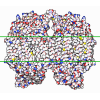[English] 日本語
 Yorodumi
Yorodumi- PDB-8b6g: Cryo-EM structure of succinate dehydrogenase complex (complex-II)... -
+ Open data
Open data
- Basic information
Basic information
| Entry | Database: PDB / ID: 8b6g | |||||||||||||||
|---|---|---|---|---|---|---|---|---|---|---|---|---|---|---|---|---|
| Title | Cryo-EM structure of succinate dehydrogenase complex (complex-II) in respiratory supercomplex of Tetrahymena thermophila | |||||||||||||||
 Components Components |
| |||||||||||||||
 Keywords Keywords | ELECTRON TRANSPORT / Ciliate / Mitochondrial / Complex-II / Supercomplex | |||||||||||||||
| Function / homology |  Function and homology information Function and homology information: / mitochondrial electron transport, succinate to ubiquinone / succinate dehydrogenase / succinate dehydrogenase (quinone) activity / anaerobic respiration / 3 iron, 4 sulfur cluster binding / tricarboxylic acid cycle / respiratory electron transport chain / 2 iron, 2 sulfur cluster binding / flavin adenine dinucleotide binding ...: / mitochondrial electron transport, succinate to ubiquinone / succinate dehydrogenase / succinate dehydrogenase (quinone) activity / anaerobic respiration / 3 iron, 4 sulfur cluster binding / tricarboxylic acid cycle / respiratory electron transport chain / 2 iron, 2 sulfur cluster binding / flavin adenine dinucleotide binding / mitochondrial inner membrane / electron transfer activity / membrane / plasma membrane Similarity search - Function | |||||||||||||||
| Biological species |  | |||||||||||||||
| Method | ELECTRON MICROSCOPY / single particle reconstruction / cryo EM / Resolution: 3 Å | |||||||||||||||
 Authors Authors | Muhleip, A. / Kock Flygaard, R. / Baradaran, R. / Amunts, A. | |||||||||||||||
| Funding support |  Sweden, European Union, 4items Sweden, European Union, 4items
| |||||||||||||||
 Citation Citation |  Journal: Nature / Year: 2023 Journal: Nature / Year: 2023Title: Structural basis of mitochondrial membrane bending by the I-II-III-IV supercomplex. Authors: Alexander Mühleip / Rasmus Kock Flygaard / Rozbeh Baradaran / Outi Haapanen / Thomas Gruhl / Victor Tobiasson / Amandine Maréchal / Vivek Sharma / Alexey Amunts /      Abstract: Mitochondrial energy conversion requires an intricate architecture of the inner mitochondrial membrane. Here we show that a supercomplex containing all four respiratory chain components contributes ...Mitochondrial energy conversion requires an intricate architecture of the inner mitochondrial membrane. Here we show that a supercomplex containing all four respiratory chain components contributes to membrane curvature induction in ciliates. We report cryo-electron microscopy and cryo-tomography structures of the supercomplex that comprises 150 different proteins and 311 bound lipids, forming a stable 5.8-MDa assembly. Owing to subunit acquisition and extension, complex I associates with a complex IV dimer, generating a wedge-shaped gap that serves as a binding site for complex II. Together with a tilted complex III dimer association, it results in a curved membrane region. Using molecular dynamics simulations, we demonstrate that the divergent supercomplex actively contributes to the membrane curvature induction and tubulation of cristae. Our findings highlight how the evolution of protein subunits of respiratory complexes has led to the I-II-III-IV supercomplex that contributes to the shaping of the bioenergetic membrane, thereby enabling its functional specialization. #1:  Journal: Biorxiv / Year: 2022 Journal: Biorxiv / Year: 2022Title: Structural basis of mitochondrial membrane bending by I-II-III2-IV2 supercomplex Authors: Muhleip, A. / Flygaard, R.K. / Haapanen, O. / Baradaran, R. / Gruhl, T. / Tobiasson, V. / Marechal, A. / Sharma, V. / Amunts, A. | |||||||||||||||
| History |
|
- Structure visualization
Structure visualization
| Structure viewer | Molecule:  Molmil Molmil Jmol/JSmol Jmol/JSmol |
|---|
- Downloads & links
Downloads & links
- Download
Download
| PDBx/mmCIF format |  8b6g.cif.gz 8b6g.cif.gz | 936.9 KB | Display |  PDBx/mmCIF format PDBx/mmCIF format |
|---|---|---|---|---|
| PDB format |  pdb8b6g.ent.gz pdb8b6g.ent.gz | Display |  PDB format PDB format | |
| PDBx/mmJSON format |  8b6g.json.gz 8b6g.json.gz | Tree view |  PDBx/mmJSON format PDBx/mmJSON format | |
| Others |  Other downloads Other downloads |
-Validation report
| Summary document |  8b6g_validation.pdf.gz 8b6g_validation.pdf.gz | 2.2 MB | Display |  wwPDB validaton report wwPDB validaton report |
|---|---|---|---|---|
| Full document |  8b6g_full_validation.pdf.gz 8b6g_full_validation.pdf.gz | 2.2 MB | Display | |
| Data in XML |  8b6g_validation.xml.gz 8b6g_validation.xml.gz | 86.3 KB | Display | |
| Data in CIF |  8b6g_validation.cif.gz 8b6g_validation.cif.gz | 125.4 KB | Display | |
| Arichive directory |  https://data.pdbj.org/pub/pdb/validation_reports/b6/8b6g https://data.pdbj.org/pub/pdb/validation_reports/b6/8b6g ftp://data.pdbj.org/pub/pdb/validation_reports/b6/8b6g ftp://data.pdbj.org/pub/pdb/validation_reports/b6/8b6g | HTTPS FTP |
-Related structure data
| Related structure data |  15866MC  8b6fC 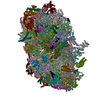 8b6hC  8b6jC M: map data used to model this data C: citing same article ( |
|---|---|
| Similar structure data | Similarity search - Function & homology  F&H Search F&H Search |
- Links
Links
- Assembly
Assembly
| Deposited unit | 
|
|---|---|
| 1 |
|
- Components
Components
-Protein , 6 types, 6 molecules CHCLCICGCECC
| #1: Protein | Mass: 22894.336 Da / Num. of mol.: 1 / Source method: isolated from a natural source / Source: (natural)  |
|---|---|
| #3: Protein | Mass: 11027.419 Da / Num. of mol.: 1 / Source method: isolated from a natural source / Source: (natural)  |
| #5: Protein | Mass: 12979.428 Da / Num. of mol.: 1 / Source method: isolated from a natural source / Source: (natural)  |
| #8: Protein | Mass: 23627.730 Da / Num. of mol.: 1 / Source method: isolated from a natural source / Source: (natural)  |
| #10: Protein | Mass: 36376.008 Da / Num. of mol.: 1 / Source method: isolated from a natural source / Source: (natural)  |
| #13: Protein | Mass: 7036.020 Da / Num. of mol.: 1 / Source method: isolated from a natural source / Source: (natural)  |
-Transmembrane protein, ... , 5 types, 5 molecules CMCFCKCJCN
| #2: Protein | Mass: 9168.366 Da / Num. of mol.: 1 / Source method: isolated from a natural source / Source: (natural)  |
|---|---|
| #7: Protein | Mass: 35124.293 Da / Num. of mol.: 1 / Source method: isolated from a natural source / Source: (natural)  |
| #9: Protein | Mass: 11188.824 Da / Num. of mol.: 1 / Source method: isolated from a natural source / Source: (natural)  |
| #11: Protein | Mass: 11957.518 Da / Num. of mol.: 1 / Source method: isolated from a natural source / Source: (natural)  |
| #12: Protein | Mass: 7244.434 Da / Num. of mol.: 1 / Source method: isolated from a natural source / Source: (natural)  |
-Succinate dehydrogenase ... , 2 types, 2 molecules CACB
| #4: Protein | Mass: 70082.758 Da / Num. of mol.: 1 / Source method: isolated from a natural source / Source: (natural)  |
|---|---|
| #6: Protein | Mass: 36002.402 Da / Num. of mol.: 1 / Source method: isolated from a natural source / Source: (natural)  |
-Protein/peptide , 2 types, 2 molecules COCD
| #14: Protein/peptide | Mass: 5158.135 Da / Num. of mol.: 1 / Source method: isolated from a natural source / Source: (natural)  |
|---|---|
| #15: Protein/peptide | Mass: 5566.625 Da / Num. of mol.: 1 / Source method: isolated from a natural source / Source: (natural)  |
-Non-polymers , 10 types, 19 molecules 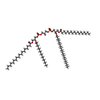

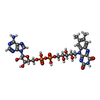
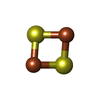

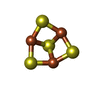
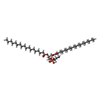
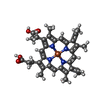
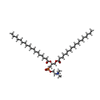










| #16: Chemical | ChemComp-CDL / #17: Chemical | #18: Chemical | ChemComp-FAD / | #19: Chemical | ChemComp-FES / | #20: Chemical | ChemComp-SF4 / | #21: Chemical | ChemComp-F3S / | #22: Chemical | #23: Chemical | ChemComp-HEC / | #24: Chemical | ChemComp-PC1 / | #25: Chemical | ChemComp-UQ8 / | |
|---|
-Details
| Has ligand of interest | Y |
|---|
-Experimental details
-Experiment
| Experiment | Method: ELECTRON MICROSCOPY |
|---|---|
| EM experiment | Aggregation state: PARTICLE / 3D reconstruction method: single particle reconstruction |
- Sample preparation
Sample preparation
| Component | Name: Succinate dehydrogenase complex (complex-II) / Type: COMPLEX Details: Complex-II of the mitochondrial respiratory chain in Tetrahymena thermophila Entity ID: #1-#15 / Source: NATURAL |
|---|---|
| Molecular weight | Value: 0.305 MDa / Experimental value: NO |
| Source (natural) | Organism:  |
| Buffer solution | pH: 7.5 |
| Specimen | Embedding applied: NO / Shadowing applied: NO / Staining applied: NO / Vitrification applied: YES |
| Vitrification | Cryogen name: ETHANE |
- Electron microscopy imaging
Electron microscopy imaging
| Experimental equipment |  Model: Titan Krios / Image courtesy: FEI Company |
|---|---|
| Microscopy | Model: FEI TITAN KRIOS |
| Electron gun | Electron source:  FIELD EMISSION GUN / Accelerating voltage: 300 kV / Illumination mode: FLOOD BEAM FIELD EMISSION GUN / Accelerating voltage: 300 kV / Illumination mode: FLOOD BEAM |
| Electron lens | Mode: BRIGHT FIELD / Nominal defocus max: 2600 nm / Nominal defocus min: 600 nm |
| Image recording | Electron dose: 25.66 e/Å2 / Film or detector model: GATAN K2 QUANTUM (4k x 4k) |
- Processing
Processing
| CTF correction | Type: PHASE FLIPPING AND AMPLITUDE CORRECTION |
|---|---|
| 3D reconstruction | Resolution: 3 Å / Resolution method: FSC 0.143 CUT-OFF / Num. of particles: 138746 / Symmetry type: POINT |
 Movie
Movie Controller
Controller






 PDBj
PDBj






